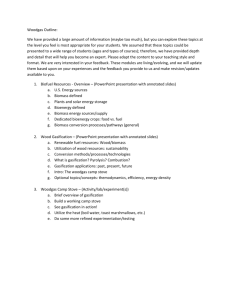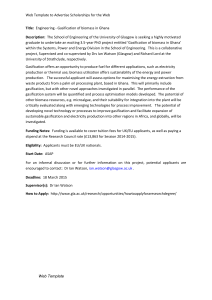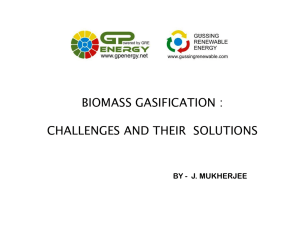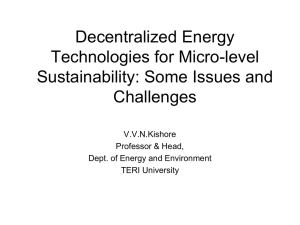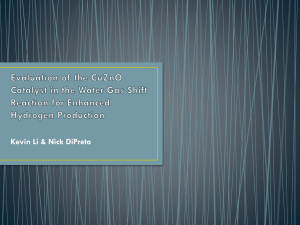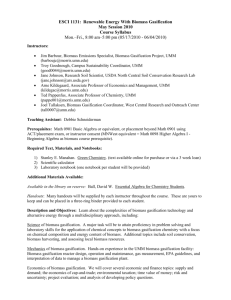Bio-mass Gasification - The Evergreen State College
advertisement
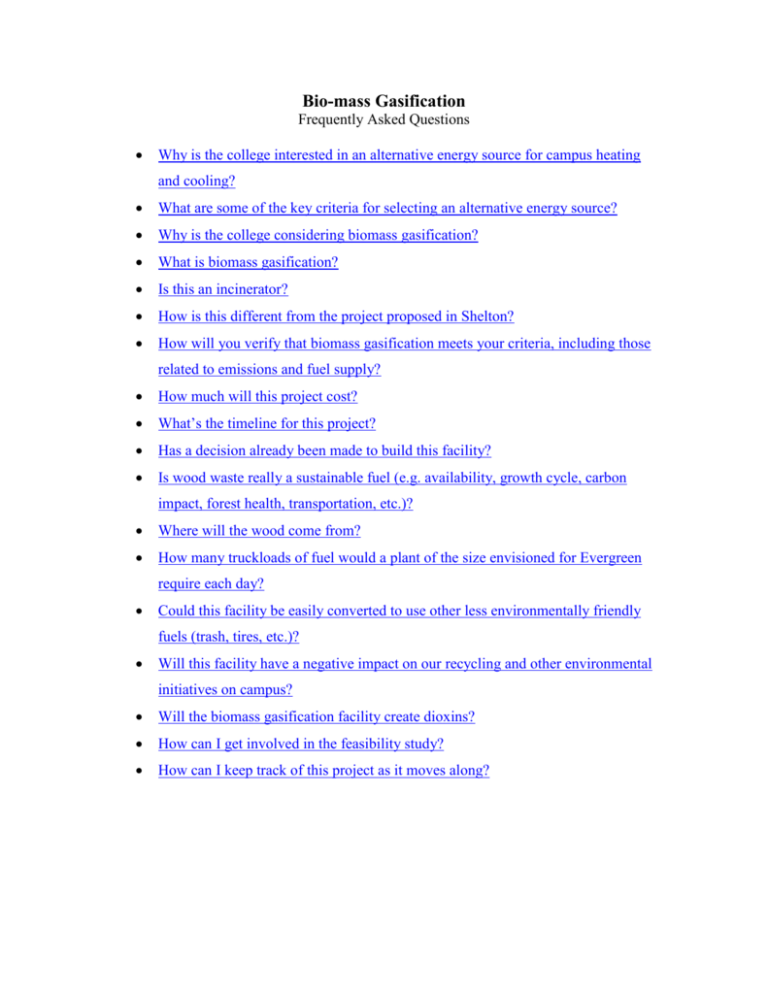
Bio-mass Gasification Frequently Asked Questions Why is the college interested in an alternative energy source for campus heating and cooling? What are some of the key criteria for selecting an alternative energy source? Why is the college considering biomass gasification? What is biomass gasification? Is this an incinerator? How is this different from the project proposed in Shelton? How will you verify that biomass gasification meets your criteria, including those related to emissions and fuel supply? How much will this project cost? What’s the timeline for this project? Has a decision already been made to build this facility? Is wood waste really a sustainable fuel (e.g. availability, growth cycle, carbon impact, forest health, transportation, etc.)? Where will the wood come from? How many truckloads of fuel would a plant of the size envisioned for Evergreen require each day? Could this facility be easily converted to use other less environmentally friendly fuels (trash, tires, etc.)? Will this facility have a negative impact on our recycling and other environmental initiatives on campus? Will the biomass gasification facility create dioxins? How can I get involved in the feasibility study? How can I keep track of this project as it moves along? Biomass Gasification Questions Why is the college interested in an alternative energy source for campus heating and cooling? While the college already purchases 100% green electricity, we can’t efficaciously use electricity for heating. The campus currently heats our buildings using natural gas, a fossil fuel, to create steam. The combustion of natural gas for heat is one of the largest contributors to our overall carbon footprint, greater even than fuel consumption related to student, staff and faculty commuting. Our goal is to become carbon neutral by 2020, so we need an action to reduce our reliance on burning natural gas. The intent of this renewable energy project is to reduce fossil greenhouse gas emissions, which have a previously unacknowledged impact on the environment. What are some of the key criteria for selecting an alternative energy source? Practical replacement of natural gas for on-demand heating Emissions comparable to burning natural gas, including nitrogen oxides (NOx), volatile organic compounds (VOC), particulates, carbon dioxide (CO2), carbon monoxide (CO), etc. Existing technology that can be located on our campus Technology suitable to our location Access to a dependable and sustainable fuel supply Minimal impact on the campus and surrounding community (emissions, noise, traffic) Cost comparable to burning natural gas Potential to create an alternative energy learning opportunity Why is the college considering biomass gasification? Evergreen graduate students (Master of Environmental Studies and Master of Public Administration) in a winter quarter 2009 class on climate action planning were asked to explore alternative energy sources to replace natural gas. They researched the probable efficacy, practicality, and costs of solar, wind, wave, tidal and hydroelectric, geothermal, kinetic, and biomass gasification energy generation systems. They concluded that, in addition to continued conservation efforts, biomass gasification had the best potential to meet the criteria noted above. Based on this initial research, our working hypothesis is that biomass gasification is the alternative energy source of choice for Evergreen. What is biomass gasification? In brief, bio-mass gasification heats wood fuel in an oxygen-starved environment to create a combustible synthesis gas ("syn-gas") that can serve as a substitute for natural gas. This differs from some bio-mass energy solutions that burn wood or other fuels 2 Biomass Gasification Questions directly. Gasification technology reduces particulates compared with direct combustion bio-mass processes by inertial or gravitational separation of particulates between the gas generator and the oxidizer (combustion) stage. In addition, any particulates in the flue (exhaust) stream will pass through an electrostatic precipitator for removal of additional particulates, especially fine ones that can adversely affect human health. The combustion by-products of filtered syn-gas are very similar to those produced by natural gas. Our design objective also includes requirements for oxides of nitrogen (NOx) reduction that should meet or exceed the emission control technology on the existing natural gas boilers. Gasification also produces a by-product (char) that can be used as a soil supplement. Our initial research indicates that the final emissions from a gasification plant will be cleaner than from other combustion or bio-mass alternatives. Is this an incinerator? No. It heats the wood fuel to create syn-gas. It burns the syn-gas to create steam, not to dispose of waste. How is this different from the project proposed in Shelton? Goals Shelton Generate electricity Make money Technology Burning wood Size/Fuel Requirement Over 100 truckloads per weekday (roughly 600,000 tons/year) Estimated to be 60 – 80 gal’s/minute New Water Demand Evergreen Generate steam for heating/cooling Reduce campus carbon footprint Emissions ≤ burning natural gas Create learning opportunity Possibly lower long term costs Gasification - heating wood to create cleaner burning syn-gas 2 truckloads a day (roughly 12,000 tons/year) No new water demand How will you verify that biomass gasification meets your criteria, including those related to emissions and fuel supply? We are conducting a feasibility study to test our hypothesis regarding biomass gasification. The feasibility study, being conducted through the summer and into the fall, is asking direct questions about these key issues and gathering data to test our initial conclusions about the technology and its application here at Evergreen. 3 Biomass Gasification Questions How much will this project cost? The working figure we are using at this point is $10 million. If we move ahead with the project, we hope to secure partners (e.g. state and federal government) to help offset some of the investment. Savings resulting from changes in fuel costs should help pay for the rest of the investment over time. The length of that payback is still being researched. What’s the timeline for this project? Summer 2005 – A Sustainability Task Force is formed and charged to “consult broadly with the campus community as it develops a deeper understanding of Evergreen's current situation and as it formulates strategies and action plans to advance sustainability at Evergreen in the coming years.” Winter 2007 – The College’s updated Strategic Plan draws upon the recommendations of the Sustainability Task Force, including a commitment to sustainability and the goal of carbon neutrality by 2020. Winter 2008 – The College’s new Master Plan also expresses the institutional goal of carbon (and waste) neutrality by 2020. Winter 2009 – Students in the MES Climate Action Planning class researched alternative energy options – including biomass gasification – and built them into Evergreen’s draft Climate Action Plan. Spring/Summer 2009 – The Climate Action Plan was reviewed and modified by Evergreen’s Sustainability Council and Sustainability Working Groups (including students, staff and faculty). Fall 2009 – The Sustainability Council publicized the Climate Action Plan, including alternative energy approaches, and posted it on the Sustainability Web site. Fall 2009/Winter 2010 – Sustainability Council and Working Group members did additional research on biomass gasification, including conversations with Middlebury College about their operational facility and site visits to an operating facility in Victoria, BC. Current/Spring 2010 The Sustainability Council is providing a focused introduction of biomass gasification plans to the campus community and requested participation in the feasibility study process. Summer 2010 4 Biomass Gasification Questions The feasibility study – funded through a partnership among the college, the State of Washington and Evergreen’s student-run Clean Energy Committee – will be conducted over the summer and into the fall. To accommodate potential funding opportunities for the overall project, the college will submit a grant request to the Washington Department of Commerce and include the biomass gasification facility in its capital budget request for the 2011-13 biennium (budget requests due in fall 2010). The Board of Trustees will be asked to approve this capital budget request. If the feasibility study determines that biomass gasification is not in the best interests of the college (for environmental, financial or other reasons), these funding requests will be changed (possibly to accommodate a better alternative) or rescinded. However, if the college does not submit these requests now, funding could be unavailable later (e.g. all grant money will be allocated to projects at other institutions and agencies) or, at a minimum, any state capital funding could be delayed into the next biennium (which starts in July 2013). Fall 2010 Results of the feasibility study will be shared with the campus community to explain the degree to which the project can meet the established criteria. If the project can meet the criteria, Senior Staff will confer with the Sustainability Council to determine a specific recommendation for the Board of Trustees (dependent on funding). Beyond Fall 2010 Further work will depend on the results of the feasibility study and availability and timing of funding. If feasible and funded, the goal is to implement the project as soon as possible to support and accelerate our carbon neutrality efforts. Has a decision already been made to build this facility? No. We are conducting a feasibility study to confirm our hypothesis that it makes sense to build the plant. Once that study is complete, we will make a decision. Is wood waste really a sustainable fuel (e.g. availability, growth cycle, carbon impact, forest health, transportation, etc.)? That’s a question we are asking in our feasibility study. Based on initial research, our hypothesis related to the viability of biomass gasification assumes that it is – especially compared to burning non-renewable natural gas. Time is a critical measure of sustainability. When we use fossil fuels and generate carbon dioxide that may take millions of years to re-sequester, we are creating a long-term imbalance that is not sustainable. One important key to sustainability lies in finding resource and waste strategies that are re-generable within a single lifetime or less. 5 Biomass Gasification Questions Growing our fuel resources is a very sustainable solution so long as we don’t use more than we can grow. We believe that our current use of natural gas from fossil deposits seriously violates the college’s sustainability goals, as articulated in the Strategic Plan. Natural gas was formed on a geological time scale, over thousands or millions of years; emissions from the combustion of natural gas, particularly the carbon, have not been a part of our global ecosystem or climate for all of that time. So although natural gas is a relatively ‘clean’ fuel, it produces greenhouse gas emissions that add to and subsequently unbalance the existing carbon cycle. This part of our hypothesis will be tested along with the other assumptions. Where will the wood come from? Our informal discussions with local timberland owners, the Washington Department of Natural Resources, and some family-owned timberland cooperatives on the Olympic Peninsula indicate that there is an enormous amount of woody debris available – many, many times what we would ever need. We don’t yet know exactly where we might source our fuel since this is a brand-new market in our area and there are no existing suppliers of chipped wood for a gasification plant. As we explore options, we are also conscious of and intent on supporting environmentally responsible fuel sources. How many truckloads of fuel would a plant of the size envisioned for Evergreen require each day? Initial estimates are two (2) truckloads per day. Could this facility be easily converted to use other less environmentally friendly fuels (trash, tires, etc.)? No. A plant in operation at Evergreen would have three very strong barriers to changes in the fuel type: 1. The technology that we are studying does not work with tires or trash. It is designed for, and only works with, plant mass. 2. It is illegal to change fuel types once an operating permit has been issued. We would have to re-apply for a new operating permit and go through a new public review and comment process in order to legally change fuels. 3. Our plans include classroom and academic program engagement with the operation of the gasification plant. Faculty and students will have daily opportunities to see what fuel is being used. 6 Biomass Gasification Questions Will this facility have a negative impact on our recycling and other environmental initiatives on campus? It should have a positive impact by creating a visible, practical demonstration of new approaches to environmental stewardship and carbon neutrality and the college’s commitment to those approaches. Efforts to reduce, reuse, and recycle will remain important initiatives on campus. Will the biomass gasification facility create dioxins? That’s a question we are asking in our feasibility study. We are looking at whether this is chemically possible given this specific fuel source (e.g. if it lacks significant amounts of sodium chloride – salt – with the required chlorine for dioxin creation) and the nature of this specific technology (low oxygen – oxygen is also required for dioxin production). If dioxin generation is possible, we want to know the levels and the implications. However, there is no indication that the plant under study would produce dioxins based on our present inquiries using the fuel sources we are considering. We’ll be making a critical evaluation of this project based on comparisons with similar installations in terms of the fuel stream (chipped wood), technology (gasification) and purpose (steam heat). Because these factors are distinctive, we won’t rely on generalizations based on comparisons with municipal waste incinerators, bio-digesters, wood-fired boilers, or other technologies that differ significantly from biomass gasification. How can I get involved in the feasibility study? Contact Scott Morgan, Sustainability Coordinator, at sustainabilityoffice@evergreen.edu or 360-867-6913. How can I keep track of this project as it moves along? Go to www.evergreen.edu/sustainability/biomass gasification.htm. 7
